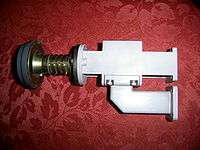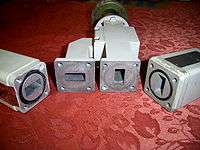Orthomode transducer




An orthomode transducer (OMT) is a waveguide component. It is commonly referred to as a polarisation duplexer. Orthomode transducers serve either to combine or to separate two orthogonally polarized microwave signal paths.[1] One of the paths forms the uplink, which is transmitted over the same waveguide as the received signal path, or downlink path. Such a device may be part of a VSAT antenna feed or a terrestrial microwave radio feed; for example, OMTs are often used with a feed horn to isolate orthogonal polarizations of a signal and to transfer transmit and receive signals to different ports.[2]
VSAT and Satellite Earth Station Applications
For VSAT modems the transmission and reception paths are at 90° to each other, or in other words, the signals are orthogonally polarized with respect to each other. This orthogonal shift between the two signal paths provides approximately an isolation of 40 dB in the Ku band and Ka band radio frequency bands.
Hence this device serves in an essential role as the junction element of the outdoor, unit (ODU) of a VSAT modem. It protects the receiver front-end element (the low-noise block converter, LNB) from burn-out by the power of the output signal generated by the block up converter (BUC). The BUC is also connected to the feed horn through a wave guide port of the OMT junction device.
Orthomode transducers are used in dual-polarized Very small aperture terminals (VSATs), in sparsely populated areas, radar antennas, radiometers, and communications links. They are usually connected to the antenna's down converter or LNB and to the High Power Amplifier (HPA) attached to a transmitting antenna.
Wherever there are two polarizations of radio signals (Horizontal and Vertical), the transmitted and received radio signal to and from the antenna are said to be “orthogonal”. This means that the modulation planes of the two radio signal waves are at 90 degrees angles to each other. The OMT device is used to separate two equal frequency signals, of high and low signal power. Protective separation is essential as the transmitter unit would seriously damage the very sensitive low (µV) micro-voltage, front-end receiver amplifier unit at the antenna.
The transmission signal of the up-link, of relatively high power (1, 2,or 5 watts for common VSAT equipment) originating from BUC,(block up converter) and the very low power received signal power (µ-volts) coming from the antenna (aerial) to the LNB receiver unit, in this case are at an angle of 90° relative to each other, are both coupled together at the feed-horn focal-point of the Parabolic antenna. The device that unites both up-link and down-link paths, which are at 90° to each other, is known as an Orthogonal Mode Transducer OMT.
In the VSAT Ku band of operation case, a typical OMT Orthomode Transducer provides a 40 dB isolation between each of the connected radio ports to the feed horn that faces the parabolic dish reflector (40 dB means that only 0.01% of the transmitter's output power is cross-fed into the receiver's wave guide port). The port facing the parabolic reflector of the antenna is a circular polarizing port so that horizontal and vertical polarity coupling of inbound and outbound radio signal is easily achieved.
The 40 dB isolation provides essential protection to the very sensitive receiver amplifier against burn out from the relatively high-power signal of the transmitter unit. Further isolation may be obtained by means of selective radio frequency filtering to achieve an isolation of 100 dB (100 dB means that only a 10−10 fraction of the transmitter's output power is cross-fed into the wave guide port of the receiver).
The second image demonstrates two types of outdoor units, a 1-watt Hughes unit and a composite configuration of a 2-watt BUC/OMT/LNB Andrew, Swedish Microwave units.
The following images show a Portenseigne & Hirschmann Ku band configuration, that highlights the horizontal the vertical, and circular polarized wave-guide ports that join to the Feed-horn, the LNB or BUC elements of an outdoor unit.
Terrestrial Microwave
An ortho-mode transducer is also a component commonly found on high capacity terrestrial microwave radio links. In this arrangement, two parabolic reflector dishes operate in a point to point microwave radio path (4 GHz to 85 GHz) with four radios, two mounted on each end. On each dish a T-shaped ortho-mode transducer is mounted at the rear of the feed, separating the signal from the feed into two separate radios, one operating in the horizontal polarity, and the other in the vertical polarity. This arrangement is used to increase the aggregate data throughput between two dishes on a point to point microwave path, or for fault-tolerance redundancy. Certain types of outdoor microwave radios have integrated orthomode transducers and operate in both polarities from a single radio unit, performing XPIC within the radio unit itself.
Training
VSAT specific training that demonstrates the use of the Orthomode Transducer (OMT):
See also
External links
- Satellite Internet and VSAT Information Centrum
- The VSAT Buyer’s Guide
- VSAT Installation Manual with explanation of the Orthomode Transducer (OMT)
References
- ↑ "orthomode transducer". Institute for Telecommunication Sciences. 1996-08-23. Retrieved 2013-06-29.
- ↑ Bartlett, Mike (2010). "FAQ". SAS Ltd. Retrieved 2013-06-29.

